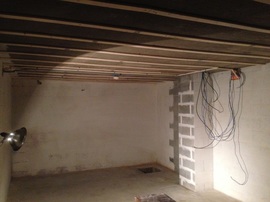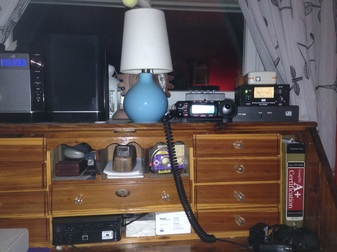Welcome to another post in my “reprint” series! As a kick off to the newly updated blog, I wanted to start by republishing some of my most visited posts, but with updated material. So, without further ado, here is the reprint.
In the Gutter
First Published 4/27/2016
If you go all the way back to the beginning of this blog, you can see the current state of my home shack. If you need a refresher, here it is again.

ed. my shack looks way better than this now! Amazing to look back in time and see how far it has come!
Due to the hecticness (is that a word?) of life, and some other home projects that needed finished ahead of this, I haven’t had time to dig into the work down here yet - but I will soon!
Even though life is busy, I still like to play radio in the house every so often. If that urge strikes and I can’t fight it, I bring my stuff in from the car and set up like this:

When I do this, the antenna I use as a temporary one is my gutters. Right outside this window is the downspout that goes up from the basement to the roof, and then the gutter runs the length of the main part of the house, about 32 feet. This means that between the downspout and gutter, I basically have a 60ish foot inverted L antenna, with the vertical part being about half of it. This works out to about 1/2 wave on 40 meters.
When I decided to use this I knew it would be temporary, so I just pounded a 6 foot piece of rebar I had into the ground at the base of the downspout. I put a ring terminal on the center conductor of the coax and screwed that to the bottom of the downspout, and then used a hose clamp to attach the shield to the rebar.
I made an ugly choke out of a few turns of the end of the coax, and connected the other end to my LDG tuner, and called it a day. Not nearly as effective as radials and proper matching would be, but it gets me on the air temporarily.
So, all of this was to bring you here: Gutter’s can make pretty darn good antenna’s!
Good enough that I’d consider burying some radials, putting in a proper ground rod, and making the coax connections a little more weather proof. I made some contacts with good reports, and low power almost right away, so I decided to measure my gutter antenna using my analyzer, and got the results that you see in the cover photo of this post.
This graph covers from 0 to 54 MHz, and almost all of it is under 5:1 SWR, so the LDG tuner that works with my radio can match it all just fine. Here are where the bands land:
- 160m is all right around 3:1
- 80m varies from 2.5:1 to 3.5:1
- 40m is the worst ranging from 4:1 to 5.3:1 (go figure!)
- 30m is all just under 4:1
- 20m is all between 2:1 and 2.5:1
- 17m is about 2:1
- 15m is all between 1.8:1 and 1.81:1
- 12m is between 2.8:1 and 3:1
- 10m is between 2.7:1 and 3.3:1
- 6m is between 1.6:1 and 3.3:1
In addition to the relatively low SWR, there are a several spots that are nearly resonant - several of those aren’t in the amateur bands, but a couple are:
- 3.780MHz
- 28.080MHz
- 51.840MHz
So if you actually read the whole way through this - what do you think? Are you gonna hook up to your downspouts and gutters and see what magic you can make happen? I know at least one of the local hams in my area uses his gutters from time to time, and I owe him a visit so that we can hook up the analyzer to his guttertenna and see how it charts out. Leave a comment and let me know your thoughts!
(ed. it’s now 2020, and I haven’t used the guttertenna in quite some time. Looking back at how decent the match was on 160m though, I’m tempted to put it back in service and maybe add a length of wire/loading coil off the end to make it electrically longer since that’s a band I don’t currently have)